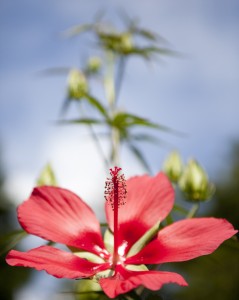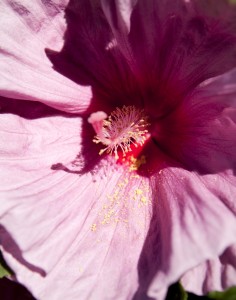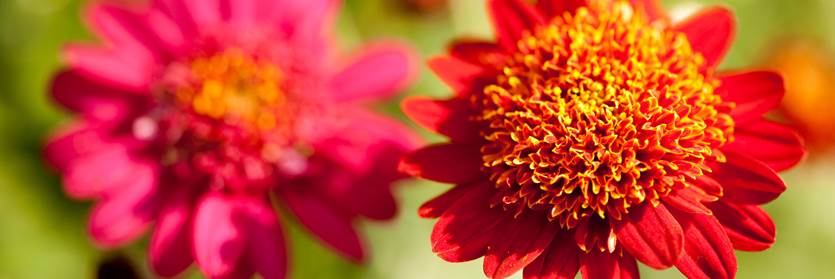What’s Beautiful Now: Hibiscus
Posted in What's Beautiful Now on August 9 2012, by Matt Newman
 New York might not strike many as a hibiscus state. Not at first. But set foot in the Home Gardening Center in August, and you could find yourself fooled (however briefly) into thinking you’ve landed in Hawaii, or Florida–spots where locals have an easy time landscaping their homes with these flowers. They show up in sunny yellows, punch bowl pinks, and whites punctuated with contrasting reds. In our trial beds, however, we’re spreading the word that hibiscus aren’t limited to places with palm trees; some species are just as suitable for your native plant garden here in the Empire State!
New York might not strike many as a hibiscus state. Not at first. But set foot in the Home Gardening Center in August, and you could find yourself fooled (however briefly) into thinking you’ve landed in Hawaii, or Florida–spots where locals have an easy time landscaping their homes with these flowers. They show up in sunny yellows, punch bowl pinks, and whites punctuated with contrasting reds. In our trial beds, however, we’re spreading the word that hibiscus aren’t limited to places with palm trees; some species are just as suitable for your native plant garden here in the Empire State!
Like the water lilies in the Conservatory pools, species of hibiscus are divided into two groups: hardy and tropical. The latter, with its broad scope of color, does well outdoors in the beach states mentioned above; they’re not big fans of frigid temperatures. But here at the NYBG, we cultivate the former variety: hardy hibiscus, equipped to handle the weather patterns New Yorkers are used to, while boasting all the cocktail umbrella charm of their tropical counterparts. A few species, such as Hibiscus moscheutos, can even be found growing natively in New York’s wetlands.
Regardless of species, it’s hard to miss these flamboyant flowers! The tall stems of Hibiscus coccineus reach out above the other varieties, showing off windmill blooms with uncommonly narrow petals. Nearby, ‘Kopper King’ flounces in the breeze like a poodle skirt, light pink blossoms promptly giving way to a rich cherry center. And ‘Cranberry Crush’ flaunts a velvety red that might just put the Valentine’s Day rose to shame.
 While “hibiscus” is the most common sobriquet for this plant, it’s also known in some regions as the rose mallow–a Malvaceae family relative of the marsh mallow (Althaea officinalis). I’m sure bells are going off in your head right about now; this white florescence has been used since Egyptian antiquity to flavor a certain sweet confection known as halva. From there, the dessert found its way into French kitchens as a meringue called pâte de guimauve, and finally to the s’mores ingredient we roast over campfires today. But while your average bag of marshmallows no longer relies on flowers for flavor (that’s what homemade hibiscus-flavored marshmallows are for), hibiscus and a few of its Malvaceae relatives still make a strong case in the culinary world. Most popular among the edible incarnations is hibiscus tea, a deep red infusion of dried Hibiscus sabdariffa sepals rich in vitamin C and beneficial minerals. Tart and tasting of cranberries, the beverage is served hot or cold in countries around the world.
While “hibiscus” is the most common sobriquet for this plant, it’s also known in some regions as the rose mallow–a Malvaceae family relative of the marsh mallow (Althaea officinalis). I’m sure bells are going off in your head right about now; this white florescence has been used since Egyptian antiquity to flavor a certain sweet confection known as halva. From there, the dessert found its way into French kitchens as a meringue called pâte de guimauve, and finally to the s’mores ingredient we roast over campfires today. But while your average bag of marshmallows no longer relies on flowers for flavor (that’s what homemade hibiscus-flavored marshmallows are for), hibiscus and a few of its Malvaceae relatives still make a strong case in the culinary world. Most popular among the edible incarnations is hibiscus tea, a deep red infusion of dried Hibiscus sabdariffa sepals rich in vitamin C and beneficial minerals. Tart and tasting of cranberries, the beverage is served hot or cold in countries around the world.
Beyond their possible health benefits, these herbaceous perennials are the natural choice for home gardeners looking for hassle-free impact. And if you’re aiming to give your New York home a touch of beach bungalow charm, you could do worse than these hand-sized trumpet flowers. You can see them now through September in the Home Gardening Center, as well as a few other spots throughout the Garden.


With all the striking, native Hibiscus species available, why do most people plant the non-native Hibiscus syriacus (Rose of Sharon)?
Thank you for showing these.